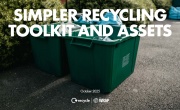OECD predicts world resource use will double by 2060

The world’s consumption of raw materials is set to double by 2060, according to a new report from the Organisation for Economic Co-operation and Development (OECD).
The OECD, which has its headquarters in Paris, is an intergovernmental organisation with 36 member countries, aiming to provide a forum for the discussion and promotion of sustainable economic policies. Its report, ‘The Global Material Resource Outlook to 2060’, sets out a worrying picture for the future of the world’s raw materials, suggesting that in under 45 years the natural environment will be under double the amount of pressure it is facing today.
Angel Gurría, Secretary General of the OECD, explained: “Growth in materials use, coupled with the environmental consequences of material extraction, processing and waste, is likely to increase the pressure on the resource bases of our economies and jeopardise future gains in well-being. This Outlook can help decision makers understand the direction in which we are heading and help to assess which policies can support a more circular economy.”
The report sets out how growing populations with growing incomes will drive up demand for goods and services, as living standards across the world begin to converge, requiring more and more raw materials – it is predicted that global materials use will more than double in the next 40 or so years, from 79 gigatonnes in 2011 to 167 gigatonnes in 2060. One gigatonne is equivalent to 1,000,000,000 tonnes.
While the recycling sector is predicted to grow faster than mining or minerals use, the report states that ‘the strong increase in demand for materials implies that both primary and secondary materials use increase at roughly the same speed’.

With more than half of all greenhouse gas emissions related to materials management activities (the extraction and processing of raw materials like biomass, fossil fuels, metals and minerals), the environmental consequence of this rise in consumption could be dramatic. Despite continual improvements in manufacturing efficiency, the OECD predicts that emissions of CO2 equivalent from materials management activities could rise to 50 gigatonnes by 2060.
The areas that will see the highest rises in resource consumption also have the most severe environmental impacts: minerals, metals and construction materials, which will see increased demand from fast-growing developing economies. Seven metals (iron, aluminium, copper, zinc, lead, nickel and manganese) responsible for seven per cent of all greenhouse gas emissions, while the large scale of global concrete production means this is responsible for nine percent of emissions.

This study follows in the footsteps of a report from the International Panel on Climate Change (IPCC), which stated that 1.5°C is the very maximum global temperature rise the world can allow before irreversible damage will occur. If the OECD’s scenario plays out, the organisation has stated that the ambitions of the 2016 Paris Climate Change Agreement, including the objective to keep global warming at well below 2°C, will not be met – meaning that ‘additional policy efforts’ will be required to meet these goals, such as ‘reducing emissions of greenhouse gases in a comprehensive resource management policy package’.
An increased need for international co-operation is underlined, as globalisation continues at a rapid rate. The OECD recommends that government focus on:
- Applying mixes of policy instruments that ensure a coherent set of incentives for resource efficiency along the product value chain.
- Implementing policies that promote resource efficiency across the lifecycle of products;
- Treating resource efficiency as an economic policy challenge and integrating it into cross-cutting and sectoral policies; and
- Strengthening policy development and evaluation through better data and analysis.









